Explore the intriguing bond between Naomi, the mother-in-law of Ruth, and how their biblical story redefines family loyalty and love.
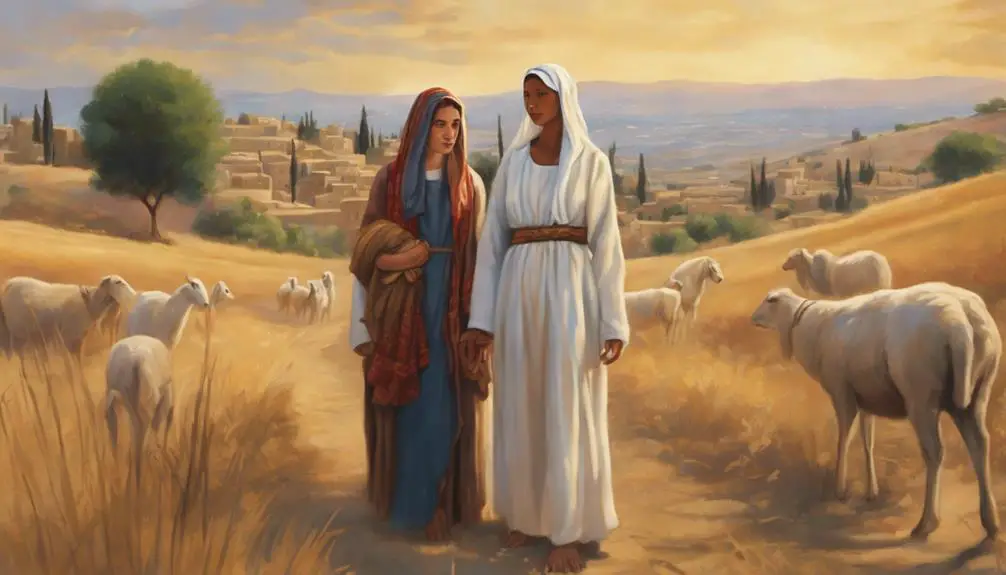
Mother in Law of Ruth in the Bible
Have you ever pondered the complex relationship dynamics between Naomi and her daughter-in-law Ruth in the Bible? You're not alone.
This narrative, unfolding in a time of famine, loss, and eventual redemption, offers a profound exploration of loyalty, love, and the bonds that defy traditional familial structures. As Naomi navigates her return to Bethlehem with Ruth by her side, their journey becomes a testament to enduring faith and the unexpected ways in which love manifests.
But what compels Ruth to make such a life-altering decision, and how does Naomi's response shape their shared future? Let's explore the layers of this story together, uncovering the lessons it holds for modern relationships.
Key Takeaways
- Naomi's journey from Bethlehem to Moab and back highlights resilience amid loss and cultural shifts.
- Her relationship with Ruth showcases unwavering loyalty that transcends familial and cultural boundaries.
- Naomi's return to Bethlehem with Ruth symbolizes hope and redemption in the face of past tragedies.
- Their legacy emphasizes the power of love and kindness in fostering community integration and inspiring generations.
Naomi's Early Life
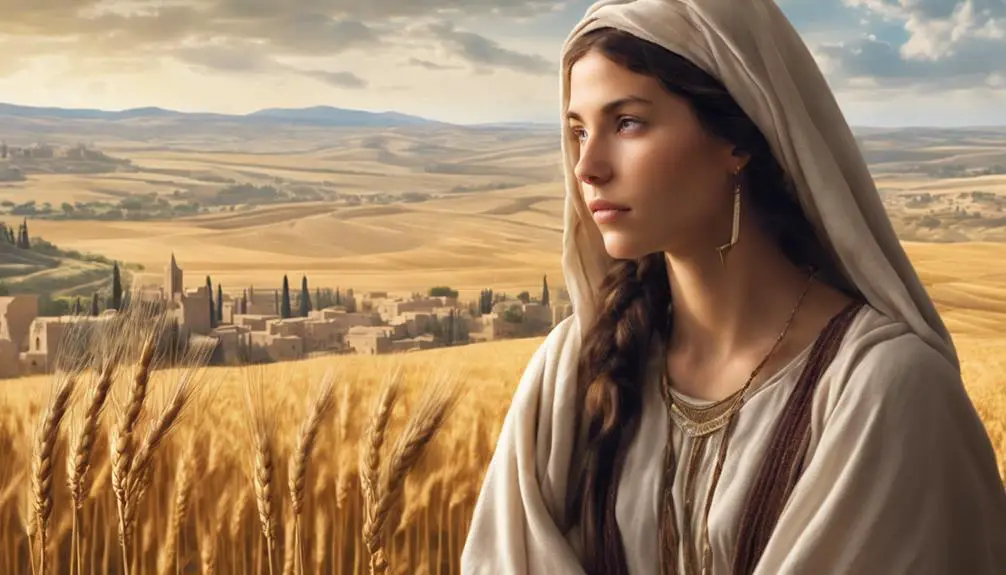
Naomi's journey began in the land of Bethlehem, where she lived before famine drove her family to Moab. You must understand that her early life, deeply rooted in family origins and marital union, is pivotal to comprehending the narrative that unfolds. Naomi's lineage, originating from Bethlehem, positioned her within a community steeped in tradition and familial loyalty. This backdrop is critical; it shapes her actions and decisions throughout her life.
Her marital union, another cornerstone of Naomi's early life, wasn't merely a personal milestone. In the context of her time, it represented a strategic alliance, a means of securing family lineage and economic stability. This union bore her two sons, further entrenching her role within the societal and familial structures.
Analyzing Naomi's early life, you recognize the weight of these elements—family origins and marital union. They're not just backdrops but active forces that influenced her character, resilience, and decisions. As famine struck, these foundational aspects of her identity dictated her subsequent actions, setting the stage for the journey to Moab. Understanding this early period in Naomi's life is essential for grasping the depth of her character and the narrative's progression.
The Journey to Moab
Driven by necessity, Naomi and her family embarked on a perilous journey to Moab, seeking refuge from the devastating famine in Bethlehem. This famine flight wasn't merely a geographical shift but also a journey fraught with cultural transitions. As you delve into the context of their migration, it's crucial to understand that crossing into Moab wasn't just about moving to a new location; it represented a significant leap into an unfamiliar cultural and religious landscape.
Moab, often viewed with suspicion and disdain by the Israelites, was a land of foreign gods and customs. For Naomi and her family, this move wasn't undertaken lightly. The decision to leave Bethlehem, their ancestral home, underlines the severity of the famine they were escaping. It also highlights the desperation that can drive individuals to cross cultural boundaries in search of sustenance and survival.
This journey to Moab underscores the themes of resilience and adaptability. Facing the unknown, Naomi's family had to navigate the complexities of integrating into a new society while maintaining their identity. This transition period was crucial, setting the stage for the unfolding of events that would later define the legacy of Naomi and her daughter-in-law, Ruth.
Loss and Loyalty
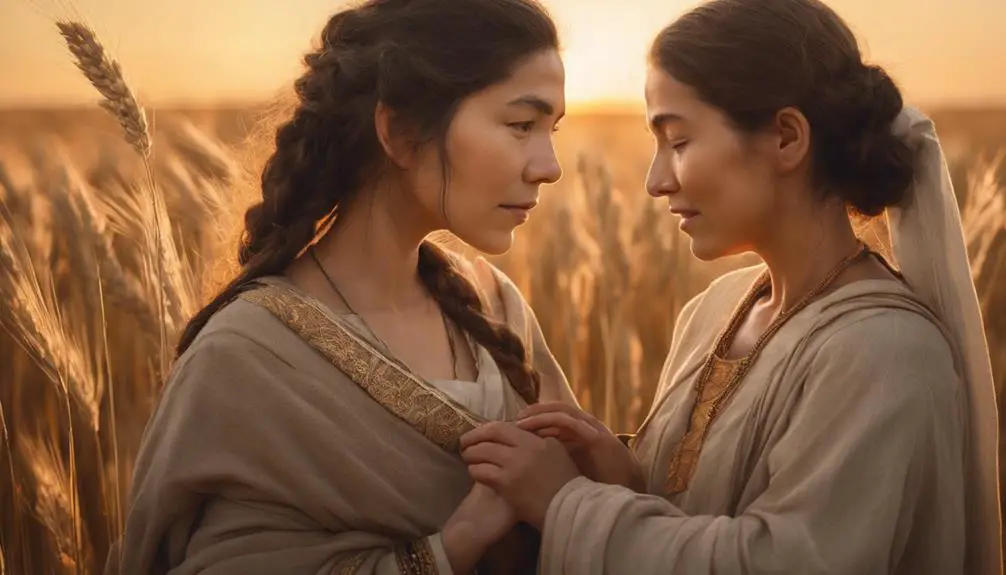
In the wake of their arrival in Moab, tragedy struck Naomi's family, leading to a profound exploration of loss and the enduring power of loyalty. You'll find that Naomi's journey through grief processing isn't just a personal struggle but a cultural adaptation to an unfamiliar land. As Naomi faced the deaths of her husband and sons, her resilience was tested, yet it was her relationship with her daughters-in-law that highlighted an extraordinary aspect of loyalty.
This saga offers a compelling look at how individuals navigate the complexities of loss within the tapestry of cultural expectations and personal beliefs. Naomi's decision to return to Bethlehem was driven by her dire circumstances, yet it was Ruth's unwavering loyalty that transformed this narrative into a testament to the strength found in unity. Ruth's choice to stay with Naomi, despite the uncertainty of their future, underscores a loyalty that transcends cultural and familial boundaries.
Their story isn't just about the grief that accompanies loss but about the loyalty that emerges from it. It serves as a powerful reminder that, even in the depths of despair, loyalty can forge an unbreakable bond, capable of overcoming the greatest of challenges. Through their journey, Naomi and Ruth redefine the parameters of family and loyalty, set against the backdrop of grief processing and cultural adaptation.
Return to Bethlehem
Deciding to return to Bethlehem, Naomi and Ruth embarked on a journey that would pivot the narrative towards redemption and the rekindling of hope within the context of ancient societal norms. Bethlehem's significance isn't merely geographical; it's a beacon of heritage and prophecy in Judeo-Christian tradition, symbolizing a return to roots and divine providence. This move, while seemingly straightforward, was layered with economic motivations and a quest for survival in a time when famine had driven Naomi away.
You must understand, Naomi's decision wasn't taken lightly. Returning to Bethlehem meant confronting the past and the loss of her husband and sons. Yet, the economic motivations behind this return were compelling. Bethlehem, despite its modest size, offered prospects of sustenance and security through the practice of gleaning — a provision in the law for the poor and the alien. Naomi and Ruth's return was a strategic move to tap into these resources, leveraging Ruth's status as a Moabite widow in a society that provided for such individuals.
Analyzing this move, you see a blend of pragmatism and faith. Bethlehem represents a fresh start, a place where loss is confronted with the potential for restoration and economic stability.
Legacy of Love
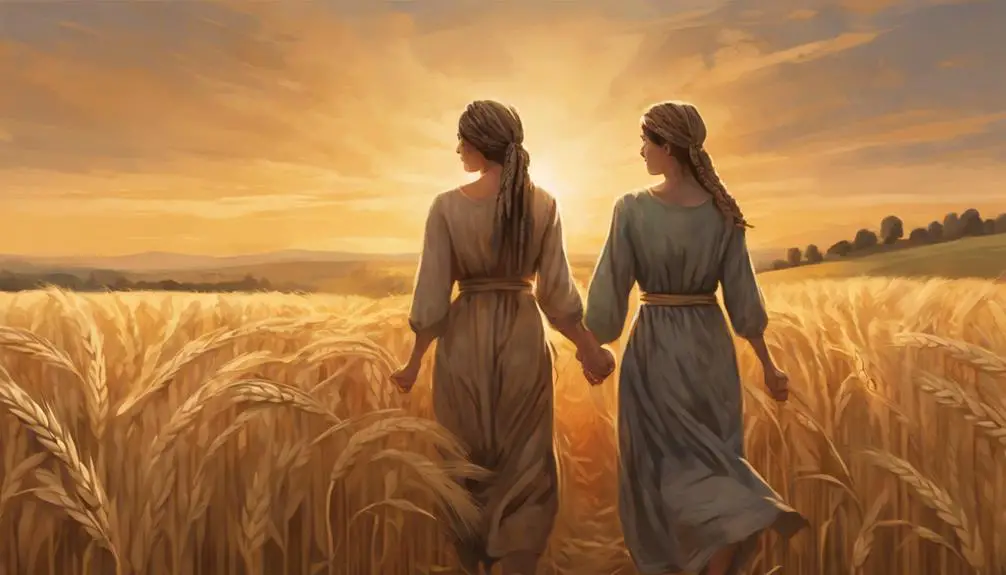
Naomi and Ruth's journey to Bethlehem not only marks a pivotal moment in their narrative but also sets the stage for a profound legacy of love that extends beyond their personal story to influence generations. This tale of enduring kindness highlights how acts of love and loyalty can transcend cultural and familial boundaries, building bridges that span across diverse cultures.
You'll find, upon deeper examination, that their story isn't merely about the resilience and dedication of two women, but also about the power of relationships to enact change. Naomi's wisdom and Ruth's unwavering commitment forge a bond that not only secures their survival but also integrates them into a community that initially viewed them with suspicion. This integration is a testament to the ways in which love and kindness can challenge and overcome societal barriers.
Moreover, their legacy of love doesn't only resonate within their immediate context but has been a beacon of hope and a source of inspiration for countless individuals across ages. It serves as a powerful reminder that enduring kindness and the willingness to build cultural bridges can leave an indelible mark on the fabric of society, echoing through time and touching lives far beyond the immediate circle of its originators.
Frequently Asked Questions
How Did Ancient Societal Norms and Laws Impact the Relationship Between Naomi and Ruth Compared to Contemporary Mother-In-Law and Daughter-In-Law Relationships?
You're exploring how cultural expectations and legal constraints shaped relationships back in ancient times compared to today.
Unlike modern relationships, ancient societal norms heavily dictated the dynamics between individuals, including familial roles.
These legal constraints and cultural expectations significantly impacted the bond between individuals, such as in-laws, making it more about duty and survival rather than personal choice or affection, differing greatly from the more flexible and personal connections seen in contemporary settings.
What Are Some Notable Artistic or Literary Works That Have Been Inspired by the Story of Naomi and Ruth?
You'll find that the story has inspired numerous musical compositions and stage adaptations, reflecting its timeless appeal. Composers and playwrights have been drawn to its themes of loyalty, love, and resilience, weaving these into works that resonate across cultures and eras.
These artistic interpretations vary widely, from classical oratorios to modern musicals, each offering a unique lens through which to explore the narrative's depth and complexity.
Are There Any Specific Rituals or Traditions in Judaism or Christianity Today That Directly Honor or Are Inspired by the Bond Between Naomi and Ruth?
In exploring traditions within Judaism and Christianity, you'll find few rituals specifically honoring the bond like Ruth's loyalty. However, cultural adaptation has woven their story into practices emphasizing kindness, commitment, and community support, reflecting their relationship's essence.
Celebrations such as Shavuot in Judaism, while not directly honoring them, echo Ruth's journey and conversion, showcasing how deeply their narrative influences values and teachings across these faiths.
How Has Feminist Theology Interpreted the Relationship and Roles of Naomi and Ruth in the Context of Scripture?
In the world of feminist theology, you'll find that the story you're curious about isn't just old hat.
Scholars have dived deep into the gender dynamics between Naomi and Ruth, offering a fresh theological reinterpretation. They analyze how these roles challenge traditional scriptural narratives, suggesting that their bond exemplifies a subversive empowerment.
This perspective not only enlightens our understanding of scripture but also redefines historical views on women's roles in religious texts.
Can the Relationship Between Naomi and Ruth Be Seen as a Model for Intergenerational Mentorship in Modern Professional or Personal Settings?
Certainly, you can view the mentorship dynamics between two individuals as reflective of generational wisdom sharing. In modern settings, this framework offers valuable insights into how experienced professionals or family members can guide younger generations.
It emphasizes the strength of intergenerational relationships, fostering a culture of learning and growth. Through such connections, both mentors and mentees benefit, crafting a supportive environment that nurtures success and personal development.
Conclusion
You might think the story of Naomi, Ruth's mother-in-law, is just another ancient tale lost in time. However, it's more than that. Naomi's journey from loss to redemption showcases a timeless lesson on resilience and the power of love.
Her unwavering loyalty and the legacy she leaves through Ruth's lineage underline the profound impact of steadfast love and faith.
So, let's not dismiss Naomi's narrative as mere history. It's a beacon of hope and a testament to enduring love's transformative power.


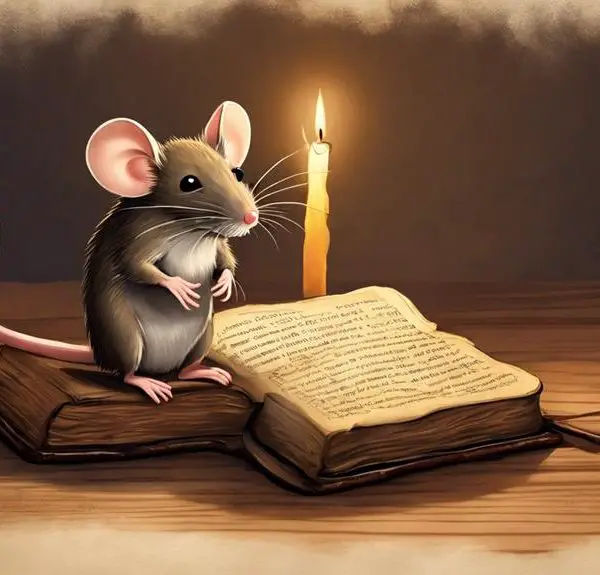
Sign up